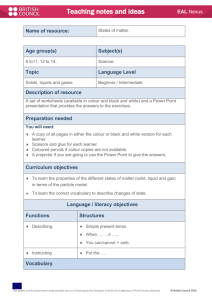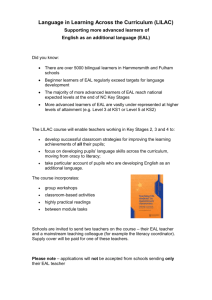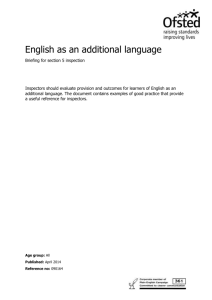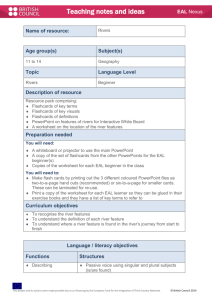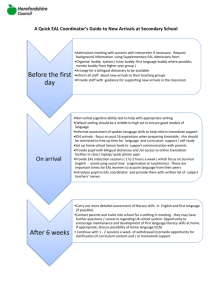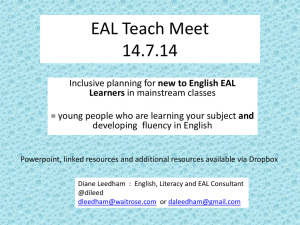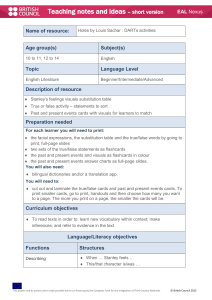- Digital Education Resource Archive (DERA)
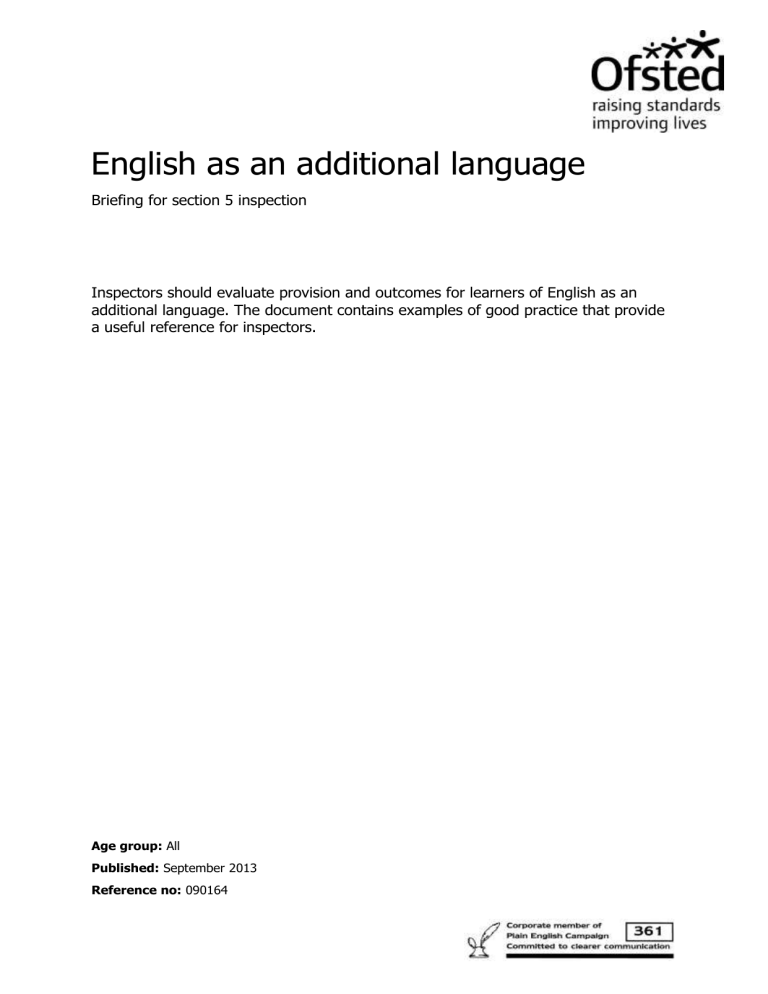
English as an additional language
Briefing for section 5 inspection
Inspectors should evaluate provision and outcomes for learners of English as an additional language. The document contains examples of good practice that provide a useful reference for inspectors.
Age group: All
Published: September 2013
Reference no: 090164
The Office for Standards in Education, Children's Services and Skills (Ofsted) regulates and inspects to achieve excellence in the care of children and young people, and in education and skills for learners of all ages. It regulates and inspects childcare and children's social care, and inspects the Children and
Family Court Advisory Support Service (Cafcass), schools, colleges, initial teacher training, work-based learning and skills training, adult and community learning, and education and training in prisons and other secure establishments. It assesses council children’s services, and inspects services for looked after children, safeguarding and child protection.
If you would like a copy of this document in a different format, such as large print or Braille, please telephone 0300 123 1231, or email enquiries@ofsted.gov.uk
.
You may reuse this information (not including logos) free of charge in any format or medium, under the terms of the Open Government Licence. To view this licence, visit www.nationalarchives.gov.uk/doc/open-government-licence/ , write to the Information Policy Team,
The National Archives, Kew, London TW9 4DU, or email: psi@nationalarchives.gsi.gov.uk
.
This publication is available at www.ofsted.gov.uk/resources/090164 .
Interested in our work? You can subscribe to our website for news, information and updates at www.ofsted.gov.uk/user .
Piccadilly Gate
Store St
Manchester
M1 2WD
T: 0300 123 1231
Textphone: 0161 618 8524
E: enquiries@ofsted.gov.uk
W: www.ofsted.gov.uk
No. 090164
© Crown copyright 2013
Background
1.
English as an additional language (EAL) refers to learners whose first language is not English. The learner may already be fluent in several other languages or dialects, which is why the term English as a second language (ESL or E2L) is inappropriate and should not be used in inspection reports. The term English for speakers of other languages (ESOL) is used in post-16 provision. The term
English as a foreign language (EFL) refers to students studying English overseas or in this country for a specific purpose. It should not be used as an alternative term for EAL.
Key resources
2.
Ofsted has published a number of case studies on outstanding practice in EAL available at: www.goodpractice.ofsted.gov.uk/ .
3.
Schools should be aware of the resources and information on supporting pupils’ learning EAL available from the Department for Education (DfE) at: www.education.gov.uk/schools/pupilsupport/inclusionandlearnersupport/eal/a0
076755/english-as-an-additional-language .
Briefing notes
4.
Below are examples of good practice that provide useful references for inspectors.
5.
RAISEonline provides data on all pupils whose first language is believed not to be English. However, pupils learning EAL are not a homogeneous group.
Inspectors should be aware of the possible variations between individuals and groups of EAL learners. Pupils come from diverse linguistic, cultural and educational backgrounds. These variations are significant when interpreting the overall achievement of EAL learners.
6.
Learners will be at different stages of English language acquisition (from complete beginner to advanced bilingual), but even those at the same stage of
English language acquisition will have different backgrounds and needs. For example, they will have had different experiences of schooling overseas. Some will be literate in other languages and might already have developed concepts in other subjects, such as science and mathematics, through another language.
Others will have had little or no formal education and might not be literate in any language. Some will be gifted or talented; others will have learning difficulties and/or disabilities.
7.
The school should monitor the attainment and progress of pupils who may be at the earliest stages of learning English. For example, schools may be using the step descriptors from A language in common: assessing English as an additional language (QCA, 2000/584). Although the scale is not statutory it was strongly recommended by the former DCSF. The school should also have taken
English as an additional language
September 2013, No. 090164
3
steps to assess the learners’ proficiency and literacy in their first language and established what prior subject knowledge and experience they have in other subjects
8.
Specialist EAL support should be available for new arrivals from qualified teachers or teaching assistants who have received appropriate training and support. More advanced learners of English should have continuing support in line with their varying needs as they develop competencies over time.
9.
Class/subject teachers should plan collaboratively with EAL support teachers or teaching assistants. There should be a focus on both language and subject content in lesson planning.
10.
The progress and attainment of all EAL learners, including those who are advanced bilingual learners, should be closely monitored so they are doing as well as they can. The cognitive challenge should remain appropriately high and not be reduced because the English language demand has been reduced. EAL learners’ conceptual thinking may be in advance of their ability to speak
English.
11.
All EAL learners have a right to access the National Curriculum and the Early
Years Foundation Stage. This is best achieved within a whole school context.
Pupils learn more quickly when socialising and interacting with their peers who speak English fluently and can provide good language and learning role models.
12.
Any withdrawal of EAL learners from a mainstream class should be for a specific purpose, time limited and linked to the work of the mainstream class; the subject/class teacher should be involved in all the planning.
13.
The school development plan should have clear objectives and strategies for the needs of EAL learners.
14.
There should be regular training for all staff on the needs of EAL learners.
15.
Any additional funding for EAL learners should be deployed strategically to support new arrivals as well as advanced bilingual learners.
4
English as an additional language
September 2013, No. 090164
